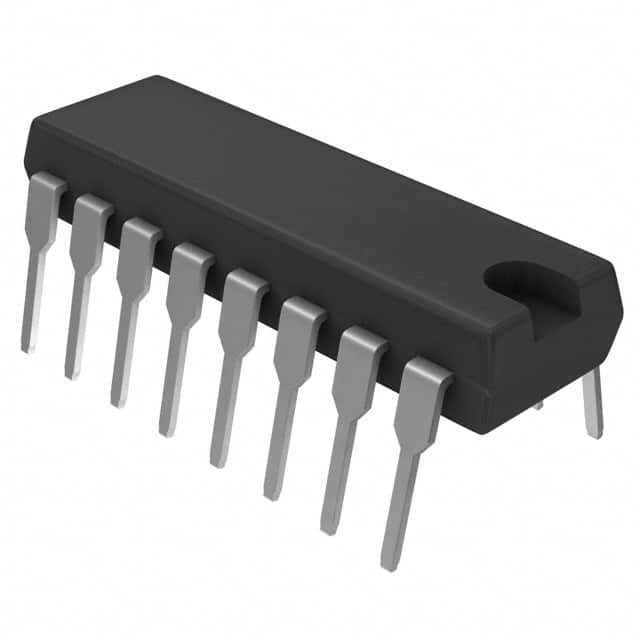Szczegóły produktu można znaleźć w specyfikacjach.

DAC0800LCN
Product Overview
Category: Integrated Circuit (IC)
Use: The DAC0800LCN is a digital-to-analog converter (DAC) IC that converts digital signals into analog voltage outputs. It is commonly used in various electronic systems where precise analog voltage generation is required.
Characteristics: - Resolution: 8 bits - Output Voltage Range: 0V to Vref - Supply Voltage Range: ±4.5V to ±18V - Low Power Consumption - Fast Conversion Speed - Easy to Interface with Microcontrollers and Digital Systems
Package: DIP (Dual In-line Package)
Essence: The DAC0800LCN is designed to provide accurate and stable analog voltage outputs based on digital input signals. It offers a cost-effective solution for applications requiring high-resolution analog voltage generation.
Packaging/Quantity: The DAC0800LCN is typically available in a plastic DIP package, which contains one IC per package.
Specifications
- Resolution: 8 bits
- Output Voltage Range: 0V to Vref (Reference Voltage)
- Supply Voltage Range: ±4.5V to ±18V
- Differential Non-Linearity (DNL): ±1 LSB
- Integral Non-Linearity (INL): ±1 LSB
- Settling Time: 100 ns
- Operating Temperature Range: -40°C to +85°C
Pin Configuration
The DAC0800LCN has a total of 16 pins, which are assigned specific functions as follows:
- Vout - Analog Output
- Iout - Current Output
- Vref - Reference Voltage Input
- AGND - Analog Ground
- CS - Chip Select (Active Low)
- WR - Write Input (Active Low)
- RD - Read Input (Active Low)
- CLK - Clock Input
- DB0-DB7 - Data Inputs (8-bit Digital Input)
- Vcc - Positive Supply Voltage
- DGND - Digital Ground
- NC - No Connection
- NC - No Connection
- NC - No Connection
- NC - No Connection
- NC - No Connection
Functional Features
- High-resolution digital-to-analog conversion
- Wide output voltage range
- Low power consumption
- Fast conversion speed
- Easy interfacing with microcontrollers and digital systems
- On-chip precision reference voltage generator
Advantages and Disadvantages
Advantages: - Accurate and stable analog voltage generation - Cost-effective solution for high-resolution applications - Easy integration with digital systems - Low power consumption
Disadvantages: - Limited output voltage range compared to some other DACs - Requires an external reference voltage source
Working Principles
The DAC0800LCN utilizes a binary-weighted resistor ladder network to convert the digital input into an equivalent analog voltage. The digital input is applied to the 8-bit data inputs (DB0-DB7), and the internal circuitry generates corresponding currents based on the input value. These currents are then converted into voltages using the external reference voltage (Vref) and delivered at the analog output pin (Vout).
Detailed Application Field Plans
The DAC0800LCN finds applications in various fields, including:
- Audio Systems: It can be used to generate precise analog audio signals for amplifiers, mixers, and equalizers.
- Instrumentation: It is suitable for generating control voltages in measurement and control systems.
- Industrial Automation: It can be utilized in process control systems to generate analog control signals.
- Communication Systems: It can be employed in communication equipment for signal modulation and demodulation purposes.
- Test and Measurement: It is useful in generating test signals for testing and calibration of electronic equipment.
Detailed and Complete Alternative Models
- DAC0808LCN: Similar to DAC0800LCN, but with 8-bit resolution and a wider output voltage range.
- DAC0832LCN: A 10-bit DAC with an extended resolution compared to DAC0800LCN.
- MCP4921: A low-power, 12-bit DAC with SPI interface and internal reference voltage.
These alternative models offer different features and specifications, allowing users to choose the most suitable option based on their specific requirements.
In conclusion, the DAC0800LCN is an 8-bit digital-to-analog converter IC that provides accurate and stable analog voltage outputs. With its wide range of applications and ease of integration, it serves as a cost-effective solution for various electronic systems requiring high-resolution analog voltage generation.
Wymień 10 typowych pytań i odpowiedzi związanych z zastosowaniem DAC0800LCN w rozwiązaniach technicznych
Sure! Here are 10 common questions and answers related to the application of DAC0800LCN:
Q: What is DAC0800LCN?
A: DAC0800LCN is a digital-to-analog converter (DAC) chip that converts digital signals into analog voltage outputs.Q: What is the operating voltage range of DAC0800LCN?
A: The operating voltage range of DAC0800LCN is typically between +5V and +15V.Q: What is the resolution of DAC0800LCN?
A: DAC0800LCN has a resolution of 8 bits, meaning it can produce 256 different output voltage levels.Q: How can I interface DAC0800LCN with a microcontroller?
A: DAC0800LCN can be interfaced with a microcontroller using parallel data lines for sending digital values and control signals.Q: What is the maximum output current of DAC0800LCN?
A: The maximum output current of DAC0800LCN is typically around 2.5 mA.Q: Can DAC0800LCN be used for audio applications?
A: Yes, DAC0800LCN can be used for basic audio applications where moderate audio quality is acceptable.Q: How accurate is the output voltage of DAC0800LCN?
A: The accuracy of the output voltage depends on factors like power supply stability and external components used. It is typically within a few millivolts.Q: Can DAC0800LCN be used in single-supply applications?
A: Yes, DAC0800LCN can be used in single-supply applications by providing a positive voltage reference and biasing the output accordingly.Q: What is the settling time of DAC0800LCN?
A: The settling time of DAC0800LCN is typically around 10 microseconds, which is the time it takes for the output voltage to stabilize after a digital input change.Q: Can multiple DAC0800LCN chips be cascaded together?
A: Yes, multiple DAC0800LCN chips can be cascaded together to increase the overall resolution or to drive multiple analog outputs simultaneously.
Please note that these answers are general and may vary depending on specific application requirements and circuit configurations.

